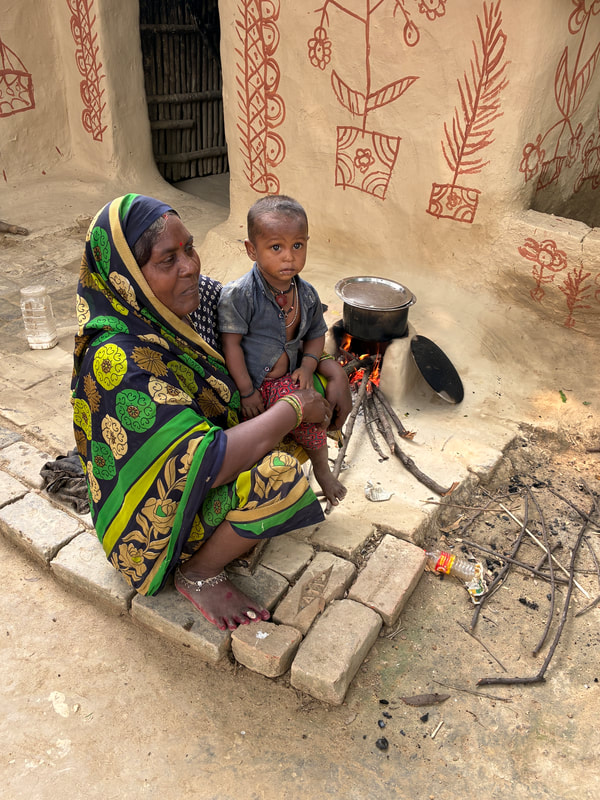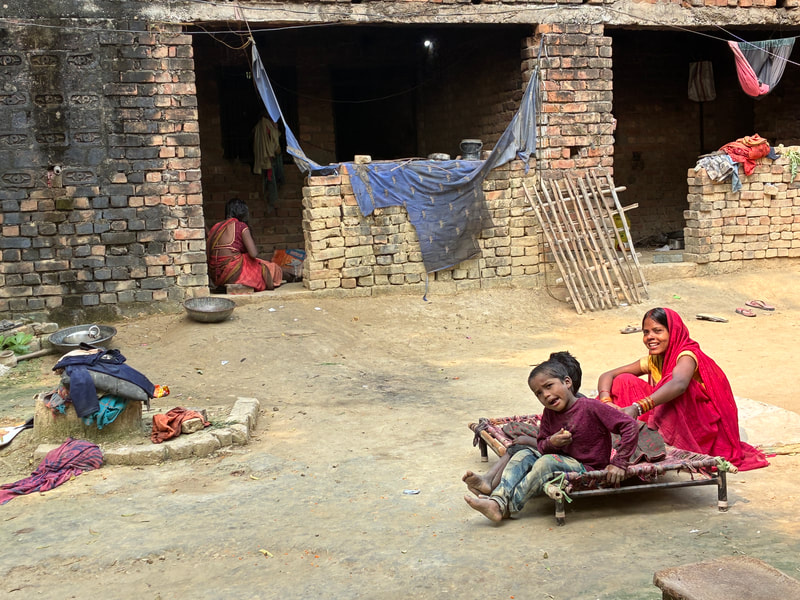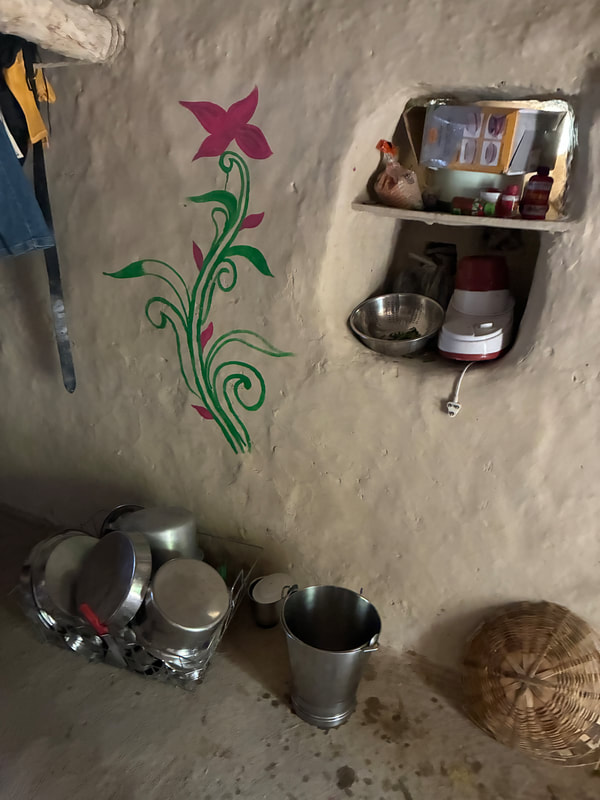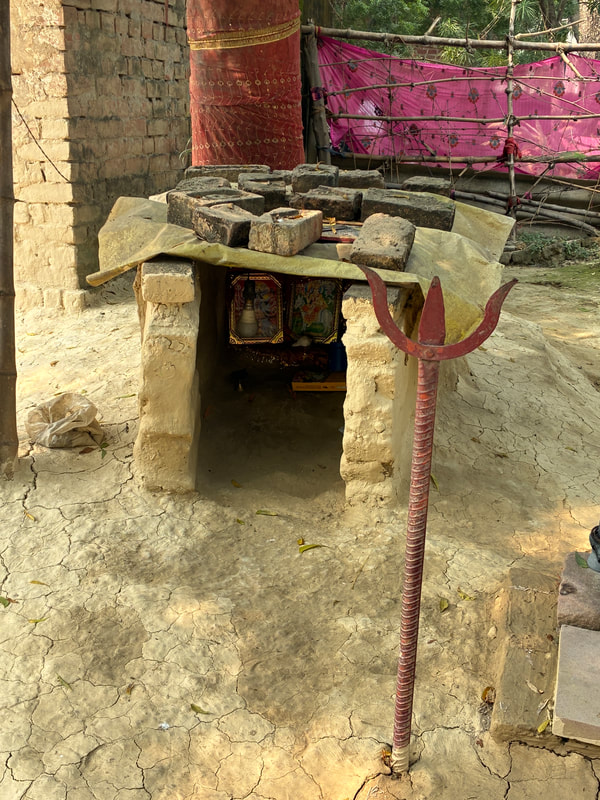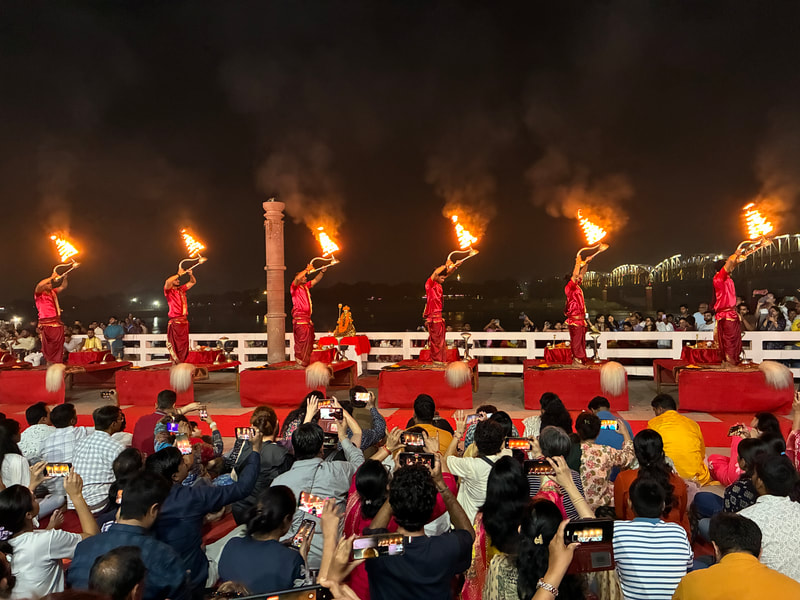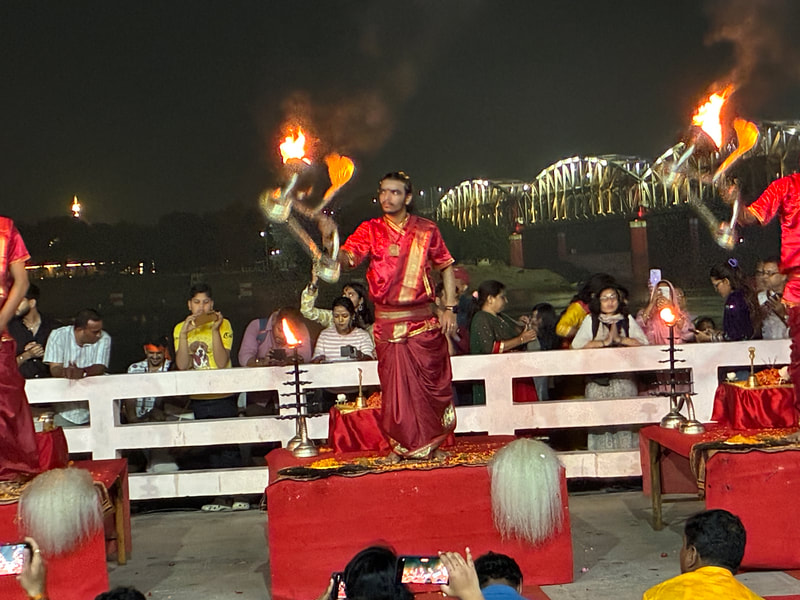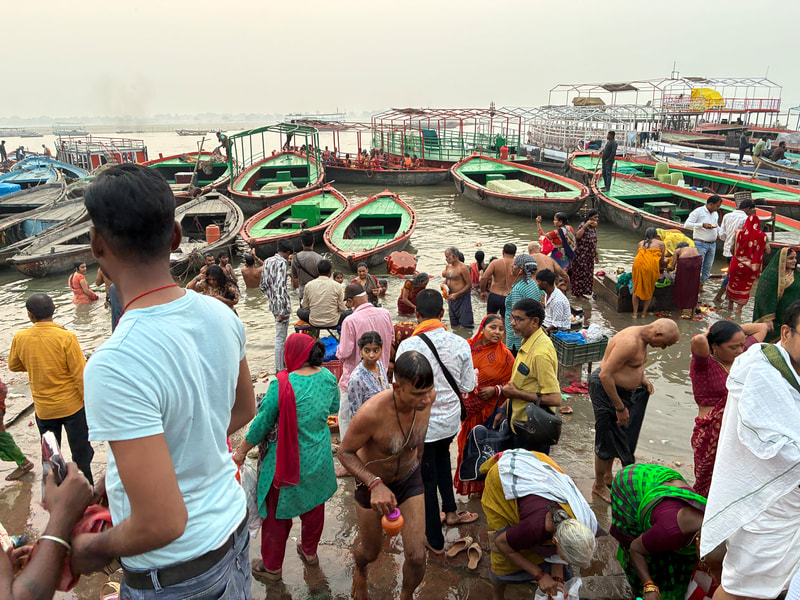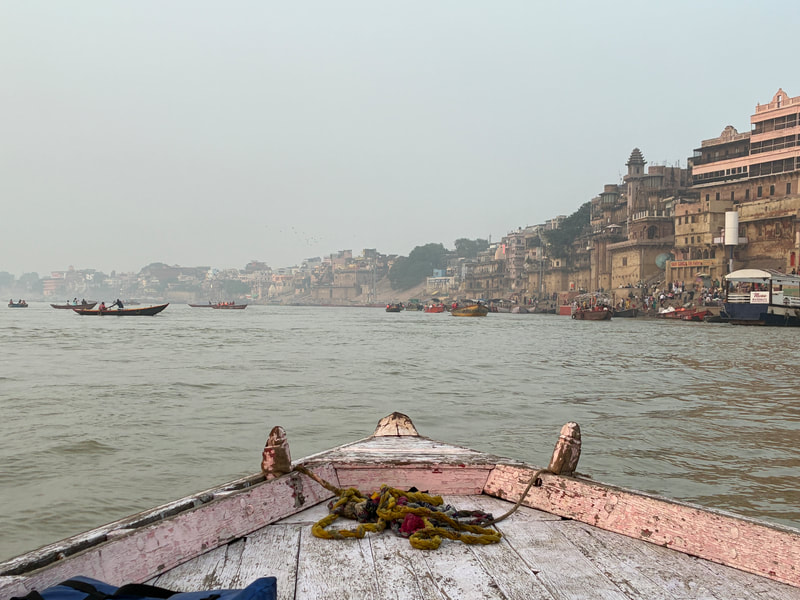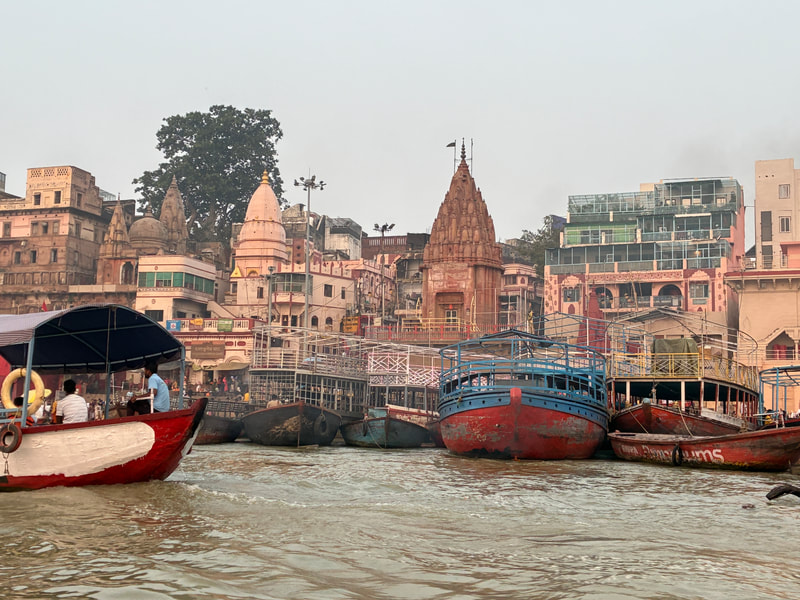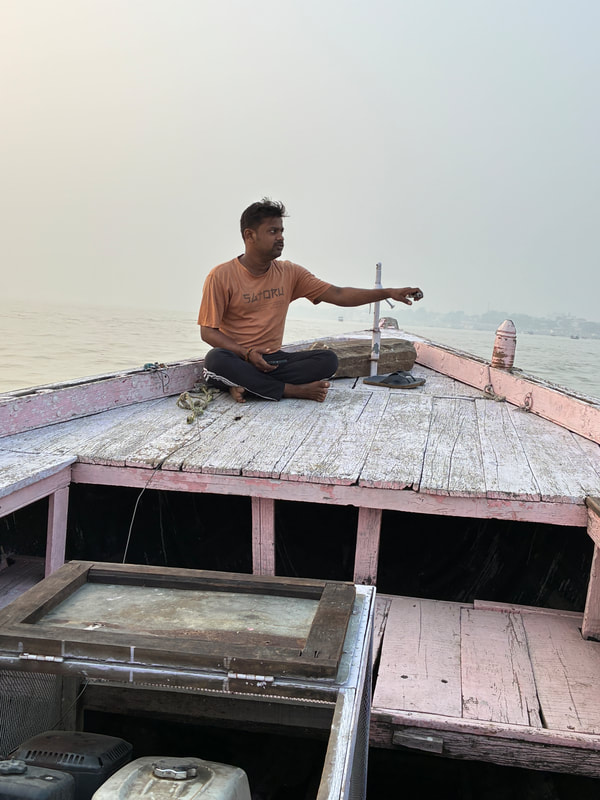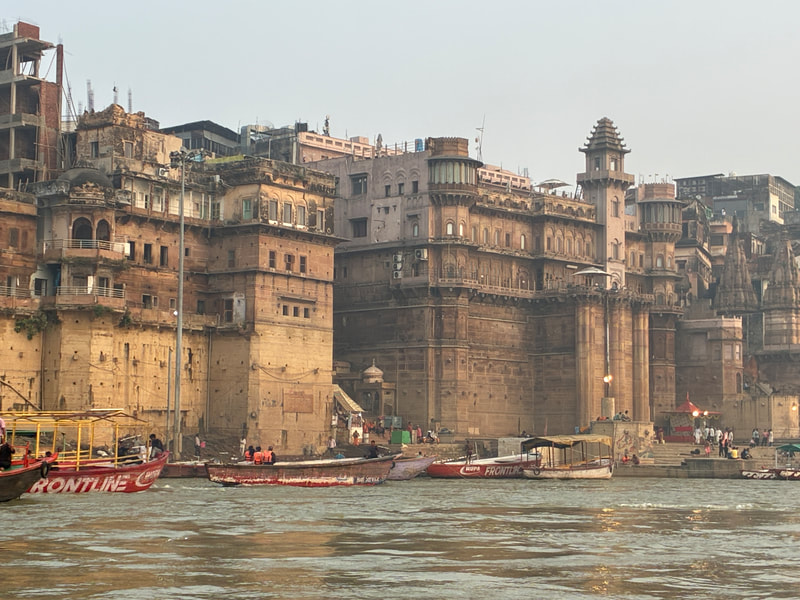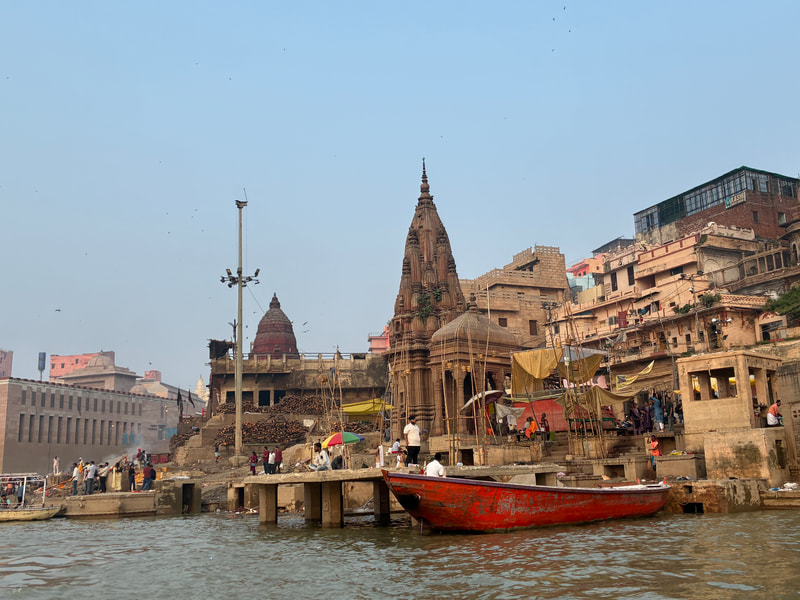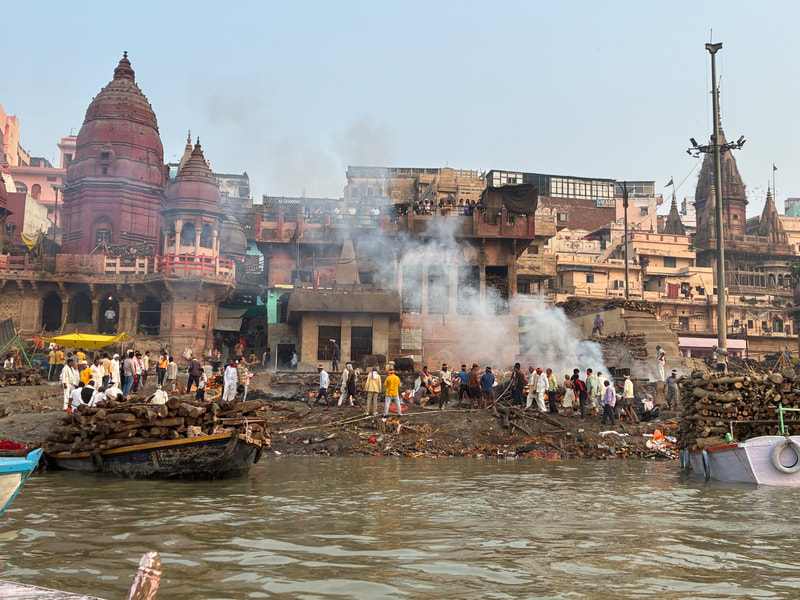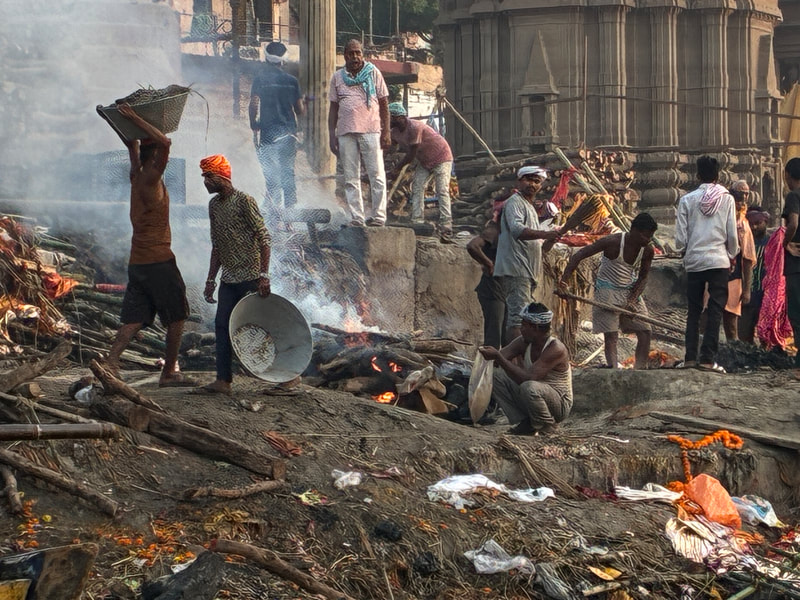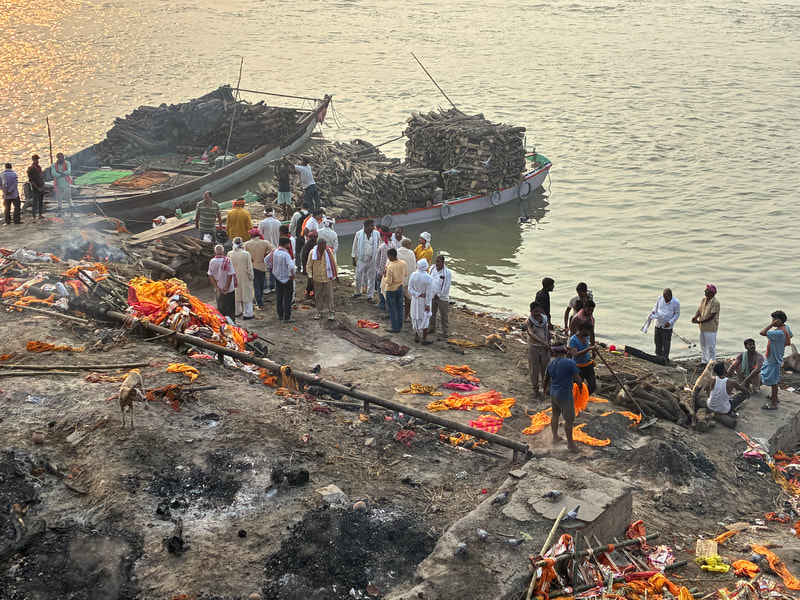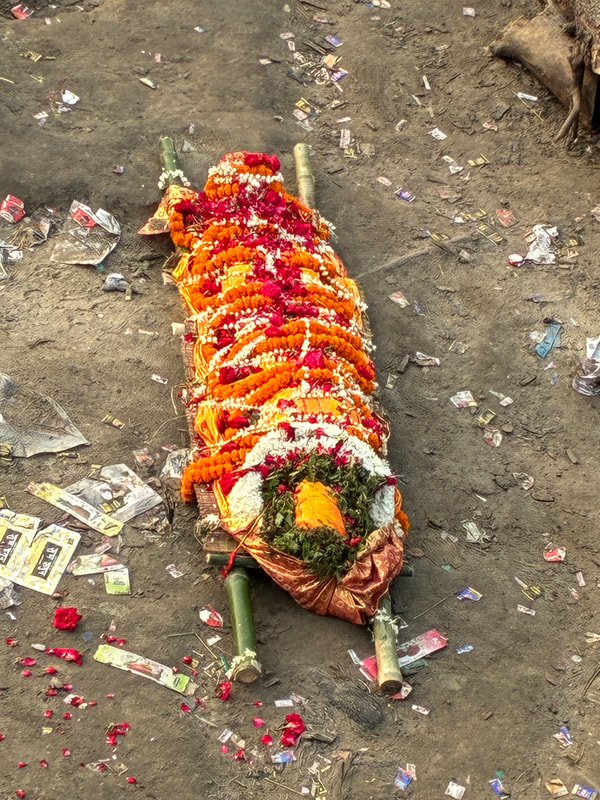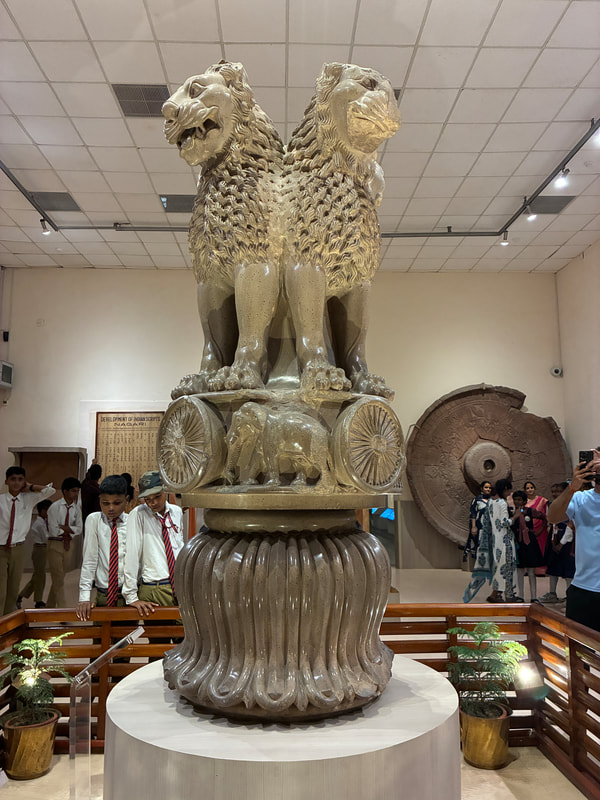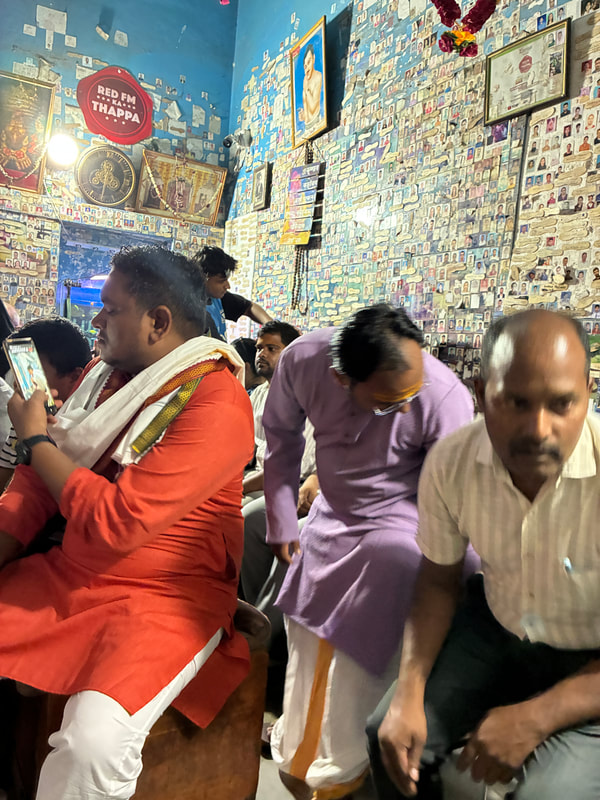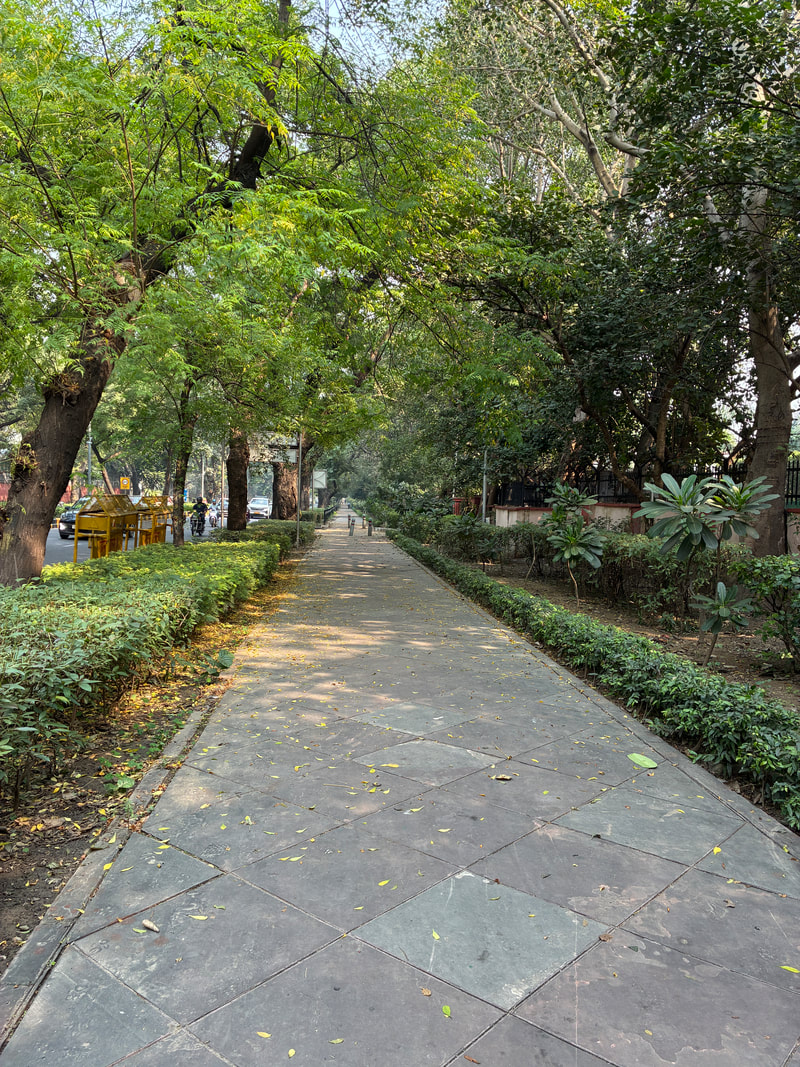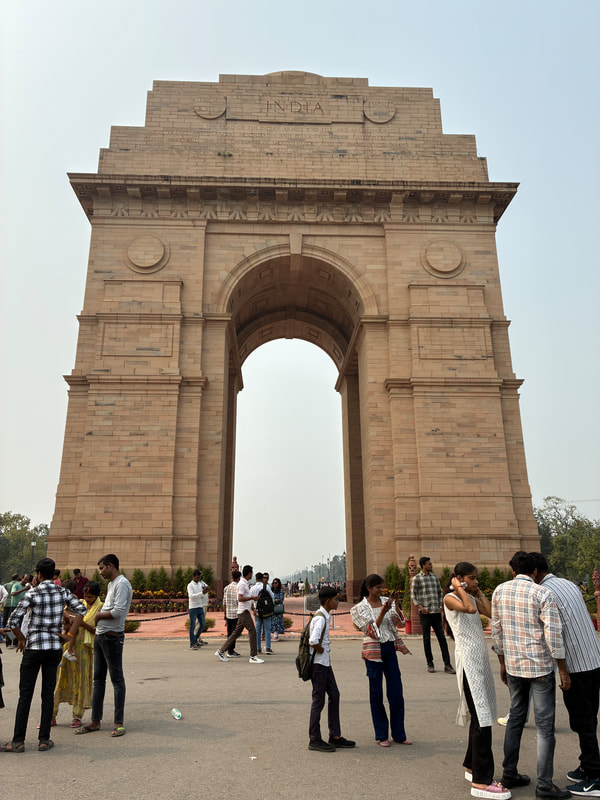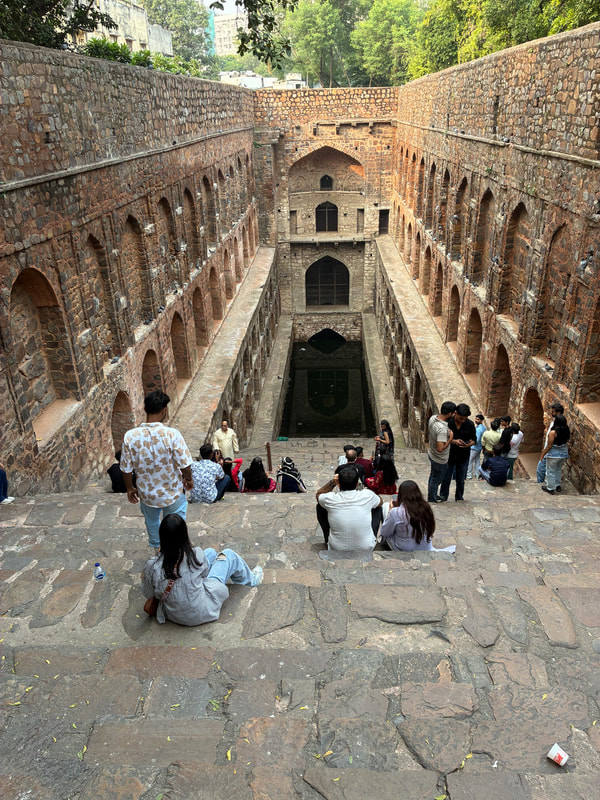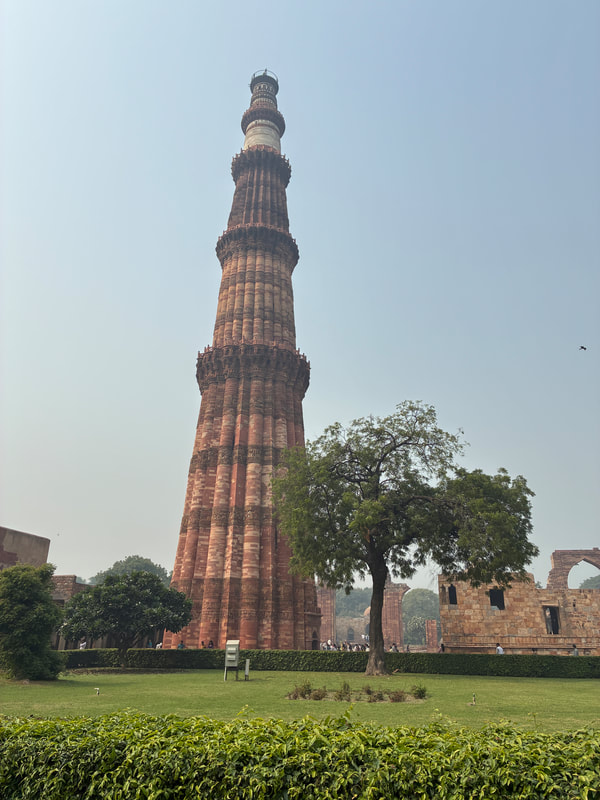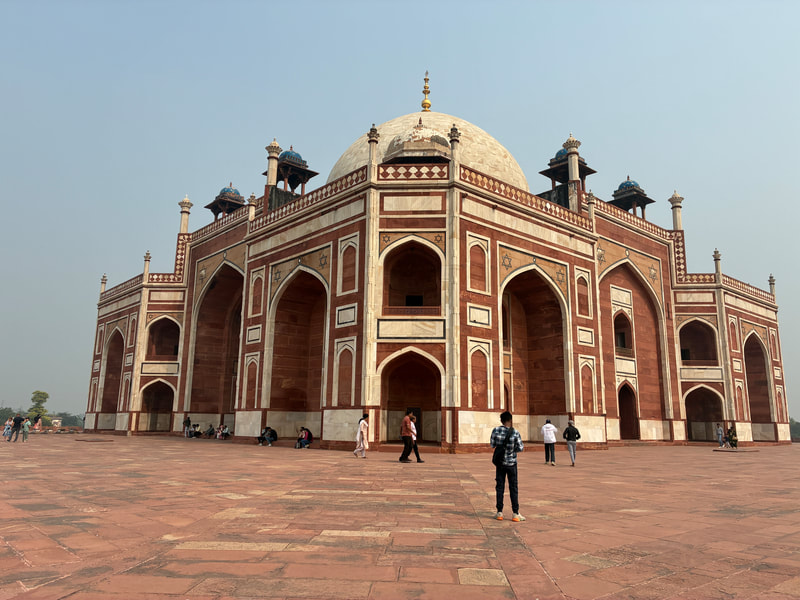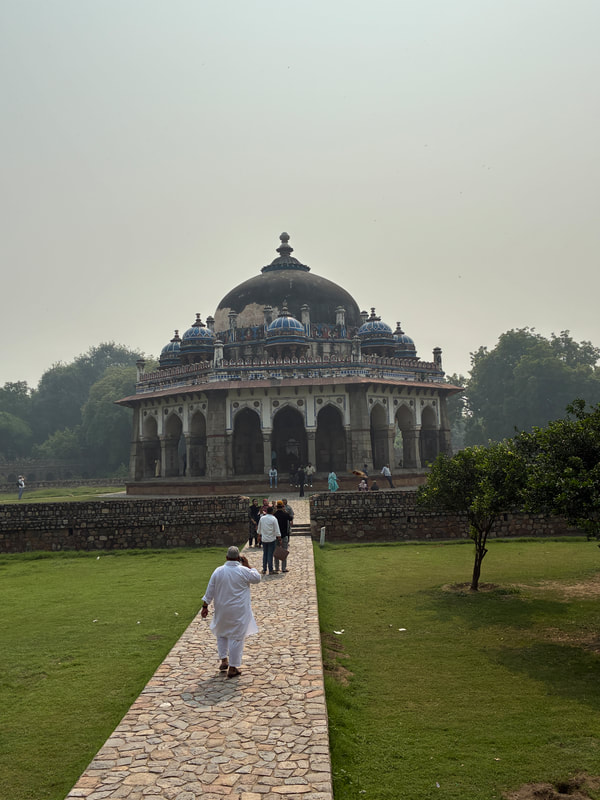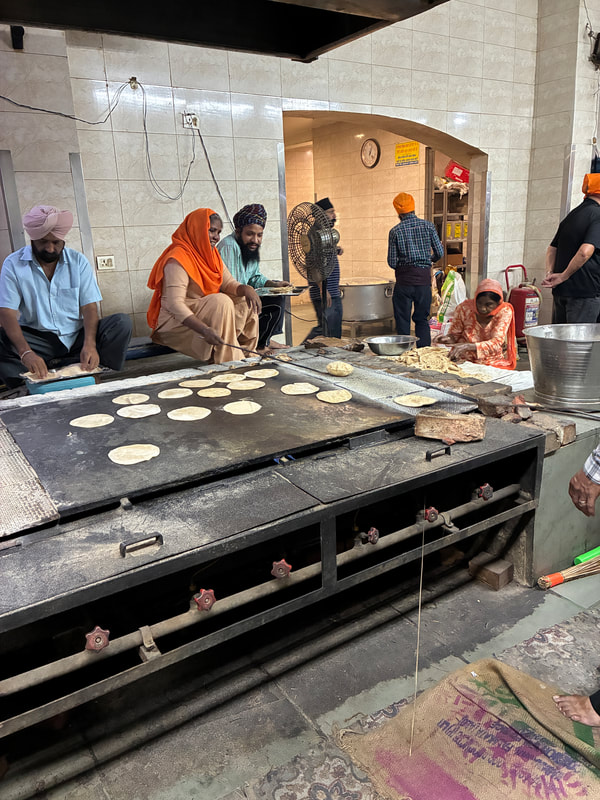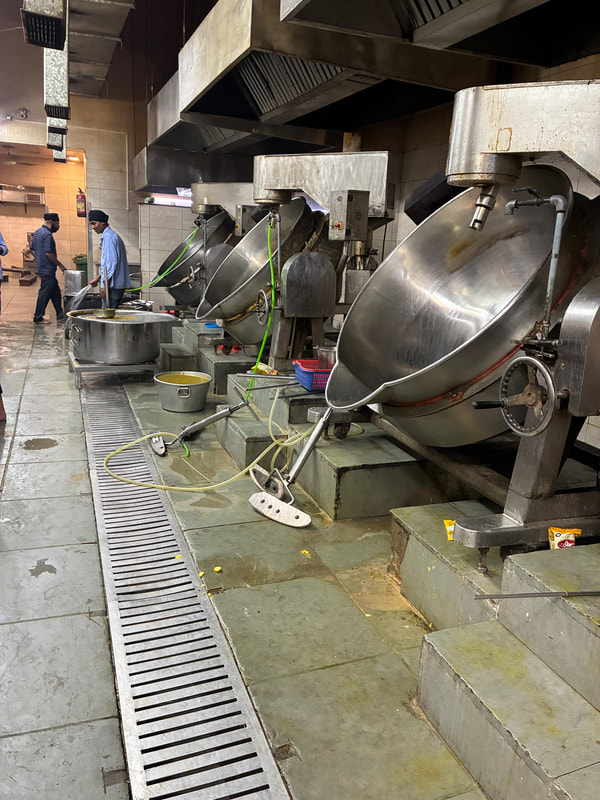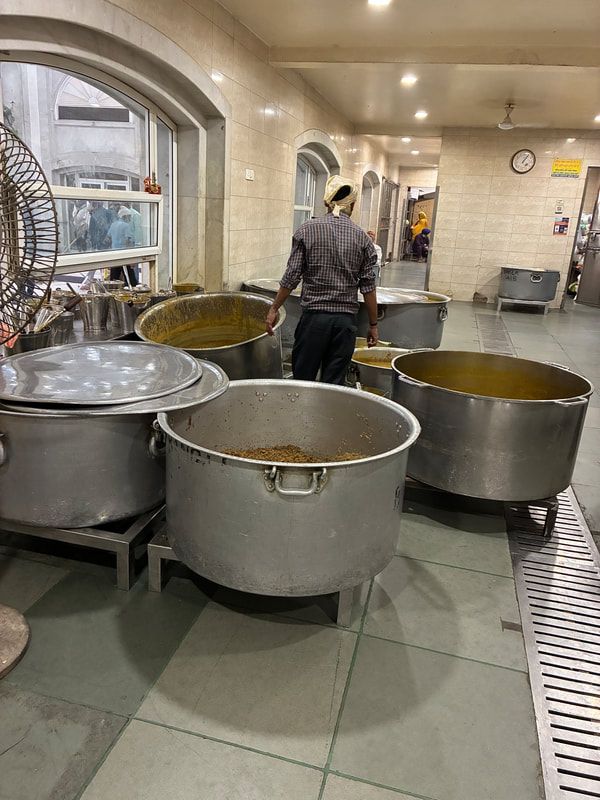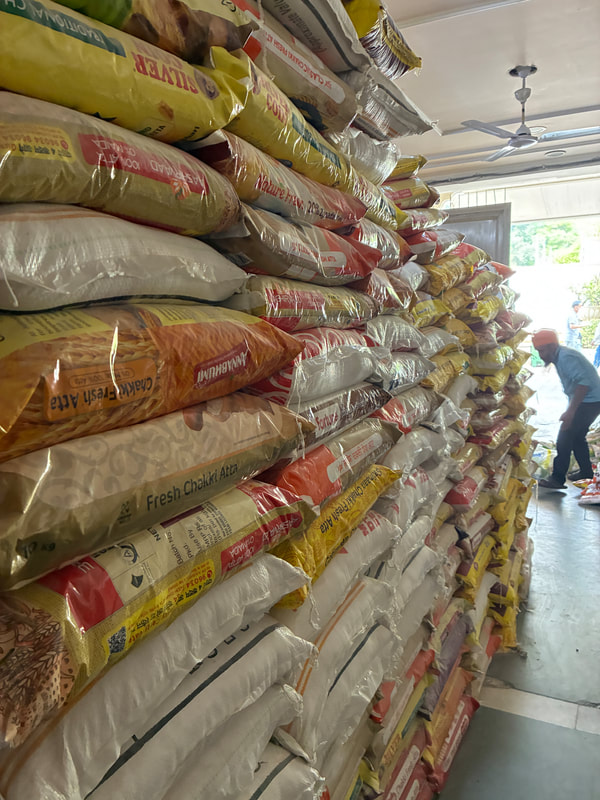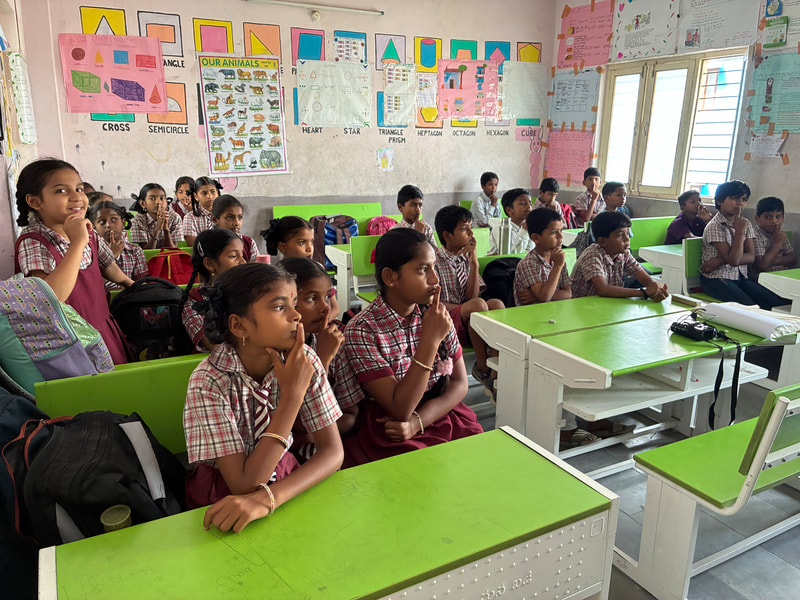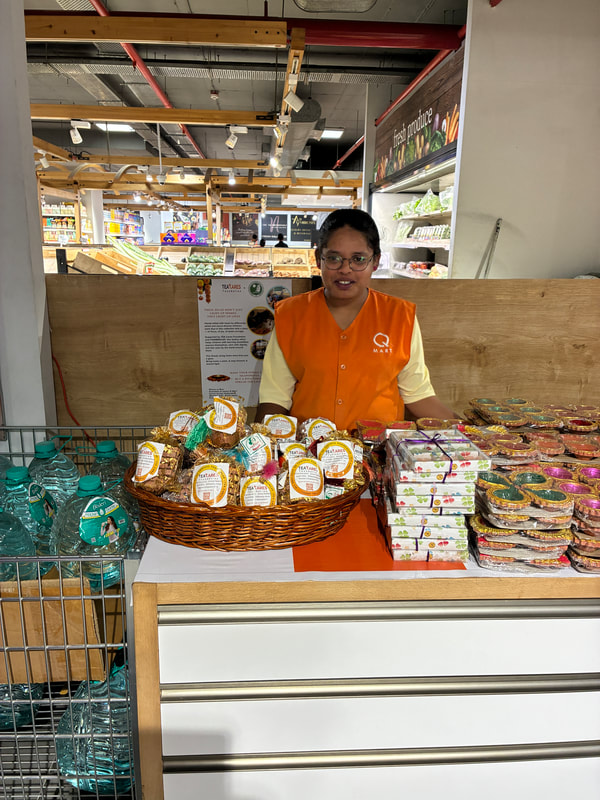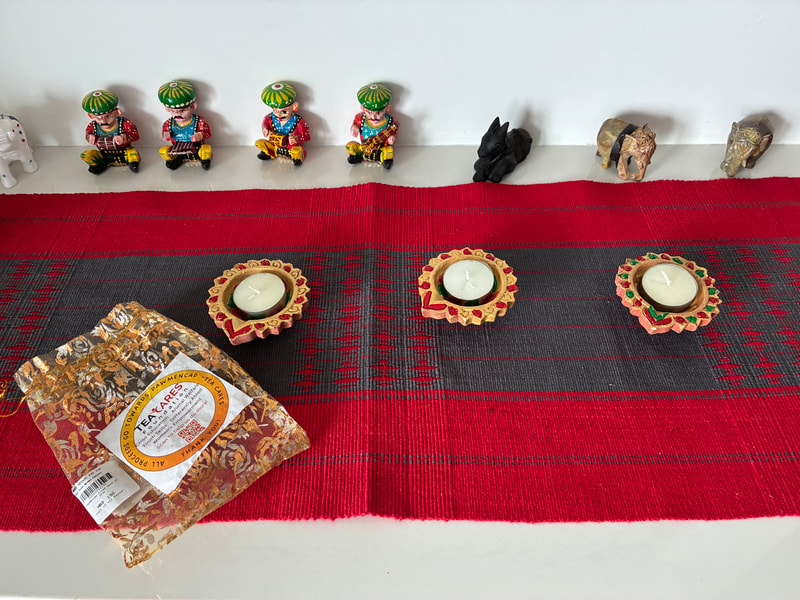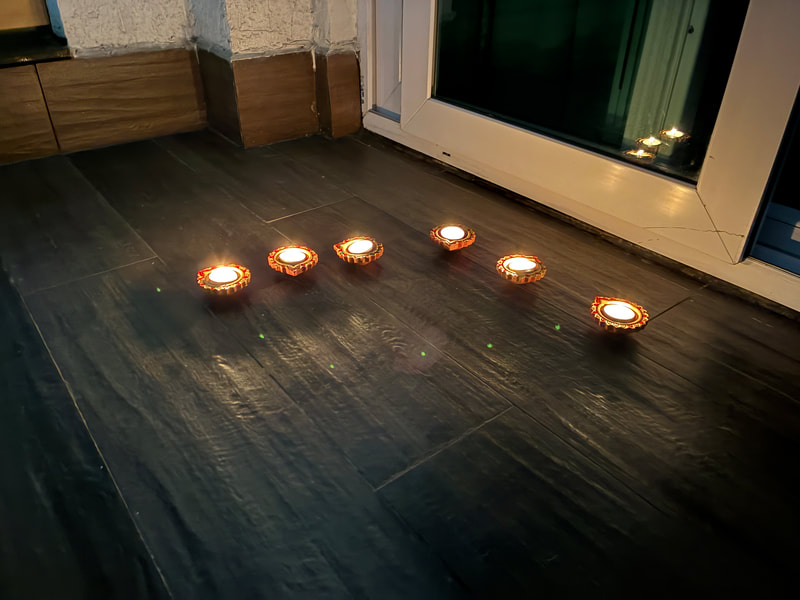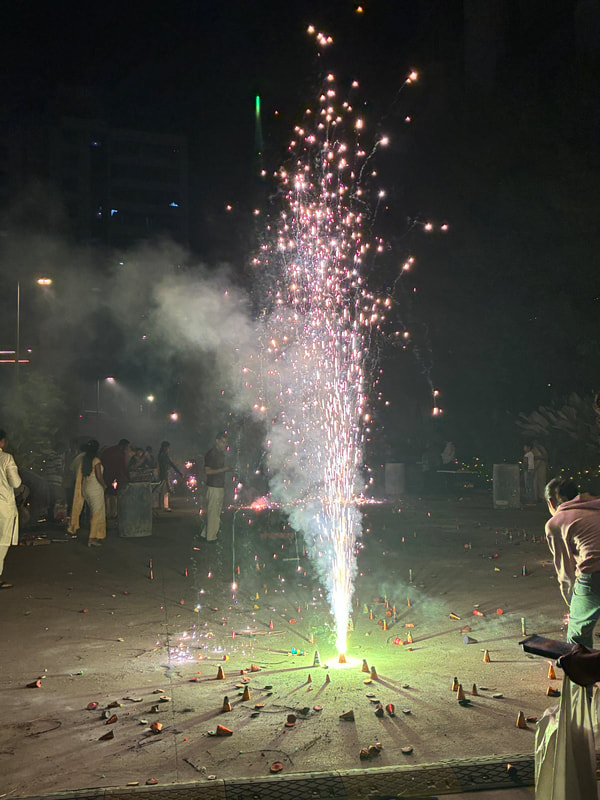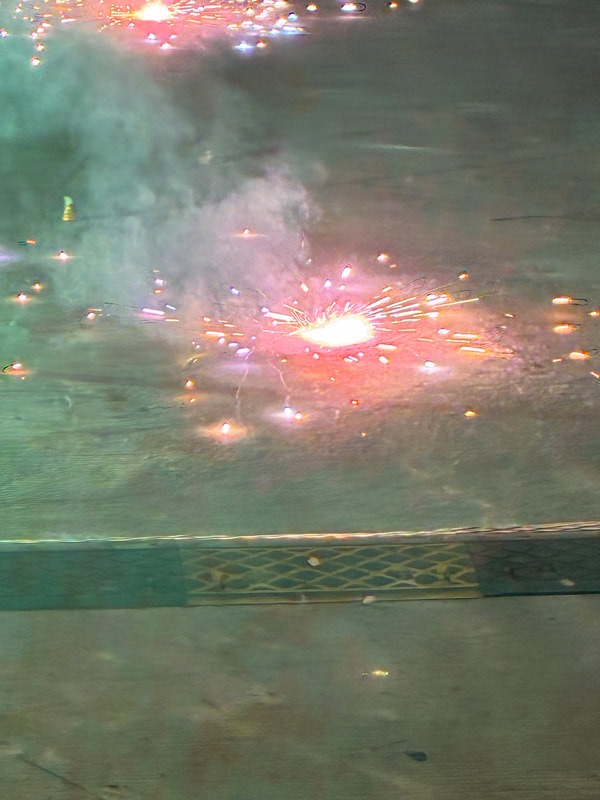|
Nandi ist der schwarze Bulle, der zu Shiva gehört. Schwarze Bullen sind deshalb hier besonders gern gesehen, auch in der sehr engen Altstadt. Das was sie hinterlassen, wird liebenswürdig "heilige Scheisse" genannt. 😂 Nandi is Shiva's black bull. Black bulls are therefore particularly welcome here, even in the very narrow old town. What they leave behind is affectionately referred to as ‘holy shit’. 😂 Nandi est le taureau noir qui appartient à Shiva. Les taureaux noirs sont donc particulièrement appréciés ici, même dans la vieille ville très étroite. Ce qu'ils laissent derrière eux est affectueusement appelé « la merde sacrée ». 😂 Varanasi ist die heiligste Stätte für Hindus. Ebenfalls wichtig ist der Ort für Anhänger des Buddhismus, Jainismus und Sikhismus. Wir haben drei ganze Tage dort verbracht und haben mit Hilfe unseres Guides extrem viele unterschiedliche Facetten dieser Stadt und deren Umgebung gesehen. Unsere Eindrücke beschreibe ich dieses Mal mit Bildern und Erklärungen dazu, jedes Mal in den drei Sprachen. Varanasi is the holiest site for Hindus. It is also important for followers of Buddhism, Jainism and Sikhism. We spent three whole days there and, with the help of our guide, saw many different facets of this city and its surroundings. This time, I will describe our impressions with pictures and explanations, each time in the three languages. Varanasi est le lieu le plus sacré pour les hindous. Il est également important pour les adeptes du bouddhisme, du jaïnisme et du sikhisme. Nous y avons passé trois jours entiers et, grâce à notre guide, nous avons pu découvrir les multiples facettes de cette ville et de ses environs. Je vais cette fois-ci décrire nos impressions à l'aide d'images et d'explications, toujours dans les trois langues. Ein Dorf von Unberührbaren. Auch wenn es diese Bezeichnung heute offiziell nicht mehr gilt, gibt es diese Menschen noch. Es ist für uns sehr schwierig zu verstehen, was Kasten bedeuten: einerseits sind sie ungerecht, andererseits geben sie Struktur, und viele Menschen möchten gar nicht aus ihrer Kaste heraus (z. Bsp. wird meistens innerhalb der Kaste geheiratet). Heute gehen alle Kinder zur Schule (wird uns gesagt), wenn die Eltern es zulassen, bzw. sich darum kümmern, ihre Kinder zu schicken. Unser Guide (Manoj) kommt von der zweit-untersten Kaste, also nicht unberührbar, aber fast. Sein Vater hatte schon etwas Bildung und so hatte Manoj die Möglichkeit (und Intelligenz) zu studieren. Er arbeitet heute selbstständig als Reiseführer, hat sein eigenes Unternehmen und ist sehr gebildet. Ihm war es sehr wichtig, dass wir dieses Dorf besuchen und mit diesen Menschen kommunizieren. Er selber geht oft dorthin, besitzt auch ein wenig Land in der Nähe. A village of untouchables. Even though this designation is no longer officially valid, these people still exist. It is very difficult for us to understand what castes mean: on the one hand, they are unjust, but on the other hand, they provide structure, and many people do not want to leave their caste (e.g., people usually marry within their caste). Today, all children go to school (we are told) if their parents allow it or take care to send them. Our guide (Manoj) comes from the second-lowest caste, as such he is not untouchable, but almost. His father had some education, so Manoj had the opportunity (and intelligence) to study. Today, he works independently as a tour guide, has his own company and is very well educated. It was very important to him that we visit this village and communicate with these people. He himself often goes there and also owns a small piece of land nearby. Un village d'intouchables. Même si cette appellation n'est plus officiellement valable aujourd'hui, ces personnes existent toujours. Il nous est très difficile de comprendre ce que signifient les castes : d'un côté, elles sont injustes, de l'autre, elles donnent une structure à la société, et beaucoup de gens ne veulent pas quitter leur caste (par exemple, les mariages se font généralement au sein de la même caste). Aujourd'hui, tous les enfants vont à l'école (c'est ce qu'on nous dit), si leurs parents les y autorisent ou s'occupent de les y envoyer. Notre guide (Manoj) est issu de la deuxième caste la plus basse, il n'est donc pas intouchable, mais presque. Son père avait déjà reçu une certaine éducation, ce qui a permis à Manoj d'avoir la possibilité (et l'intelligence) de faire des études. Il travaille aujourd'hui comme guide indépendant, possède sa propre entreprise et possède une vaste culture générale. Il tenait beaucoup à ce que nous visitions ce village et communiquions avec ces gens. Il s'y rend souvent lui-même et possède également un petit terrain à proximité. Wir sind am Ganges und in der Stadt, in der Lord Shiva verehrt wird. Die Nachtbilder zeigen die Zeremonie, die jeden Abend für Shiva an verschiedensten Orten in Varanasi, immer am Ufer der "Mutter Ganga", gehalten wird. Sie spricht verschiedenste Sinne an und wir verstehen, dass viele Menschen, auch junge, in den Bann von solchen Zeremonien gezogen werden. Im Bild rechts sieht man, wie Menschen im Ganges baden: es ist das Reinigungsritual für Hindus. Es befreit sie von Sünden und sie können im besten Fall aus dem Kreislauf von Leben und Tod, bzw. Wiedergeburt ausbrechen. We are at the Ganges and in the city where Lord Shiva is worshipped. The night-time pictures show the ceremony held every evening for Shiva at various locations in Varanasi, always on the banks of ‘Mother Ganga’. It appeals to a wide range of senses, and we understand that many people, including young people, are captivated by such ceremonies. The picture on the right shows people bathing in the Ganges: this is the purification ritual for Hindus. It frees them from sin and, in the best case scenario, they can break out of the cycle of life and death, or rebirth. Nous sommes au bord du Gange, dans la ville où l'on vénère le dieu Shiva. Les photos prises de nuit montrent la cérémonie qui est célébrée chaque soir en l'honneur de Shiva à différents endroits de Varanasi, toujours sur les rives de la « mère Ganga ». Elle fait appel à tous les sens et nous comprenons que beaucoup de gens, y compris des jeunes, soient fascinés par ce genre de cérémonies. Sur la photo de droite, on voit des gens se baigner dans le Gange : c'est le rituel de purification des hindous. Cela les libère de leurs péchés et, dans le meilleur des cas, ils peuvent sortir du cycle de la vie et de la mort, ou de la réincarnation. Morgendliche Bootsfahrt auf dem Ganges. Morning boat trip on the Ganges. Tour matinal en bateau sur le Gange In Varanasi zu sterben, kann die Erlösung (Moksha) bringen. Deshalb möchten viele Hindus hier sterben und verbrannt werden. Die Toten werden so bald wie möglich nach dem Sterben mit den entsprechenden Ritualen verbrannt, und die Asche wird in den Ganges gestreut. Das erste Bild zeigt das ewige Feuer, mit dem der Scheiterhaufen entzündet wird. Auf dem letzte Bild sieht man, wie ein Toter zum Einäscherungsort durch die Stadt getragen wird. Das Ritual wird ausschliesslich von Männern durchgeführt (auch wenn eine Frau gestorben ist), dauert einige Zeit und die Teilnehmenden wirken entspannt-fröhlich. Der Tod in Varanasi ist eine Erlösung, also nicht traurig. Es ist kein Problem, dass wir zuschauen; das Verbrennen ist ein öffentlicher Akt. Dying in Varanasi can bring salvation (moksha). That is why many Hindus want to die and be cremated here. The dead are cremated as soon as possible after death with the appropriate rituals, and the ashes are scattered in the Ganges. The first picture shows the eternal fire used to light the pyre. The last picture shows a dead person being carried through the city to the cremation site. The ritual is performed exclusively by men (even if a woman has died), takes some time and the participants appear relaxed and cheerful. Death in Varanasi is a liberation, so it is not sad. It is not a problem for us to watch; cremation is a public act. Mourir à Varanasi peut apporter la rédemption (Moksha). C'est pourquoi de nombreux hindous souhaitent mourir et être incinérés ici. Les morts sont incinérés dès que possible après leur décès, selon les rituels appropriés, et leurs cendres sont dispersées dans le Gange. La première image montre le feu éternel qui sert à allumer le bûcher funéraire. Sur la dernière photo, on voit un mort transporté à travers la ville vers le lieu de crémation. Le rituel est exclusivement accompli par des hommes (même lorsqu'il s'agit d'une femme décédée), dure un certain temps et les participants semblent détendus et joyeux. À Varanasi, la mort est une libération, elle n'est donc pas triste. Il n'y a aucun problème à regarder, la crémation est un acte public. Varanasi, bzw. Sarnath (ein wenig ausserhalb von Varanasi), ist auch für Buddhisten ein wichtiger Ort. Hier soll Buddha seine erste Predigt gehalten haben. Deshalb gab es hier einmal einen buddhistischen Tempel mit anderen Gebäuden. In Sarnath gibt es auch ein Museum mit wunderschönen Buddhastatuen und (mittleres Bild) der Statue mit den vier Löwen und dem "Dharmachakra", dem Rad der Lehre oder des Gesetzes. Letztere heisst das Löwenkapitell von Ashoka und bildet das Staatswappen von Indien. Varanasi, or Sarnath (just outside Varanasi), is also an important place for Buddhists. It is here that Buddha is said to have given his first sermon. That is why there used to be a Buddhist temple here, along with other buildings. In Sarnath, there is also a museum with beautiful Buddha statues and (middle picture) the statue with the four lions and the ‘Dharmachakra’, the wheel of doctrine or law. The latter is called the Lion Capital of Ashoka and forms the national emblem of India. Varanasi, ou plutôt Sarnath (un peu à l'extérieur de Varanasi), est également un lieu important pour les bouddhistes. C'est ici que Bouddha aurait prononcé son premier sermon. C'est pourquoi il y avait autrefois un temple bouddhiste avec d'autres bâtiments. À Sarnath, il y a également un musée avec de magnifiques statues de Bouddha et (photo du milieu) la statue avec les quatre lions et le « Dharmachakra », la roue de l'enseignement ou de la loi. Cette dernière est appelée le chapiteau aux lions d'Ashoka et constitue l'emblème national de l'Inde. Wir essen auch sehr gut hier 😋. Oben links ein Thali, rechts "Puri" als Streetfood, unten Fruchtjoghurt, das wir in einer super kleinen Bude bekommen und essen. We also eat very well here 😋. On the top left is a thali, on the top right is "puri" as street food, and on the bottom is fruit yoghurt, which we get and eat in a tiny little shop. Nous mangeons également très bien ici 😋.
À gauche en haut, un thali, à droite, du "puri" vendu dans la rue, en bas, des yaourts aux fruits que nous recevons et mangeons dans un tout petit établissement.
0 Comments
Das erste, was mir in Delhi aufgefallen ist sind die grossen Alleen mit wunderschönen Bäumen und angenehmen Trottoirs. Wir waren dann auch in einem der schönsten Hotels, in denen ich je war (ich habe noch zwei Gutscheine einlösen können, die mir zum Abschied von meiner Arbeit geschenkt worden waren). Am ersten Tag haben wir das India Gate (eine Art Arc de Triomphe in Erinnerung an die indischen Soldaten, die im ersten Weltkrieg gefallen sind) und den dazugehörigen Park zu Fuss erkundet. Danach waren wir mit einer Autoriksha unterwegs: Wir haben das alte und neue Parlament, den President‘s Palace und das alte Wasserreservoir mit Treppe "Agrasen Ki Baoli" gesehen. Anschliessend waren wir im National Museum, in dem alte Kunst ausgestellt ist. Am zweiten Tag waren wir mit einem Guide unterwegs und haben weitere grosse Monumente besucht: das Qutub Minar (ein 73 m hoher Turm aus dem 12. Jahrhundert, der den Sieg der Muslime über die Hindus feiert), das Humayun Grab (1565 gebaut, eine der ersten Mughal-Architekturen), einen Sikh Tempel (hier werden jeden Tag ca. 35'000 Essen kostenlos herausgegeben) und wir waren ein wenig in der Altstadt spazieren. Schliesslich waren wir am letzten Tag in der National Gallery of Modern Art, wo Bilder und Skulpturen ab dem 19. Jahrhundert ausgestellt sind und die Entwicklung der Kunst in Indien bis in die heutige Zeit aufgezeigt wird. India Gate, Agrasen's Stepwell, Qutub Minar The first thing I noticed in Delhi were the wide avenues lined with beautiful trees and pleasant pavements. We also stayed in one of the most beautiful hotels I have ever been to (I was able to redeem two vouchers that I had been given as a farewell gift when I left my job). On the first day, we explored India Gate (a kind of Arc de Triomphe in memory of the Indian soldiers who fell in the First World War) and the adjoining park on foot. Afterwards, we took an auto rickshaw and saw the old and new parliament buildings, the President's Palace and the old water stepwell, ‘Agrasen Ki Baoli’. Afterwards, we went to the National Museum, where ancient art is exhibited. On the second day, we took a tour with a guide and visited other major monuments: the Qutub Minar (a 73-metre-high tower from the 12th century celebrating the victory of the Muslims over the Hindus), Humayun's Tomb (built in 1565, one of the first examples of Mughal architecture), a Sikh temple (where around 35,000 meals are served free of charge every day) and we took a short walk through the old town. Finally, on the last day, we visited the National Gallery of Modern Art, where paintings and sculptures from the 19th century onwards are exhibited, illustrating the development of art in India up to the present day. Humayun's Tomb and (right) the Sikh temple (Gurdwara Bangla Sahib) La première chose qui m'a frappé à Delhi sont les grandes avenues bordées de magnifiques arbres et dotées de trottoirs agréables. Nous avons également séjourné dans l'un des plus beaux hôtels où j'ai jamais été (j'ai pu utiliser deux bons qui m'avaient été offerts lorsque j'ai quitté mon travail). Le premier jour, nous avons exploré à pied l'India Gate (une sorte d'Arc de Triomphe à la mémoire des soldats indiens tombés pendant la Première Guerre mondiale) et le parc qui l'entoure. Ensuite, nous avons pris un autorickshaw : nous avons vu l'ancien et le nouveau parlement, le palais présidentiel et l'ancien réservoir d'eau avec son escalier « Agrasen Ki Baoli ». Nous avons ensuite visité le Musée national, où sont exposées des œuvres d'art anciennes. Le deuxième jour, nous avons pris un guide et avons visité d'autres grands monuments : le Qutub Minar (une tour de 73 m de haut datant du XIIe siècle, qui célèbre la victoire des musulmans sur les hindous), le tombeau de Humayun (construit en 1565, l'un des premiers édifices de style moghol), un temple sikh (où environ 35 000 repas sont distribués gratuitement chaque jour) et nous nous sommes promenés un peu dans la vieille ville. Enfin, le dernier jour, nous avons visité la National Gallery of Modern Art, où sont exposés des tableaux et des sculptures d'à partir du XIXe siècle et qui retracent l'évolution de l'art en Inde jusqu'à nos jours. Die Küche im Sikh Tempel: alle arbeiten freiwillig und jede Person, egal welcher Herkunft oder Religion, darf hier essen. Das ganze ist sehr gut organisiert und es werden jeweils so viele Leute reingelassen, wie Platz haben. Ich nehme an, dass die Wartezeiten eher lang sind.
The kitchen in the Sikh temple: everyone works voluntarily and anyone, regardless of their origin or religion, is allowed to eat here. The whole thing is very well organised and groups of as many people as there is room for are allowed in. I assume that the waiting times are rather long. La cuisine du temple sikh : tout le monde travaille bénévolement et chaque personne, quelle que soit son origine ou sa religion, peut venir manger ici. Tout est très bien organisé et les personnes sont admises par groupe qui ont de la place; les uns après les autres. Je suppose que les temps d'attente sont plutôt longs. Es ist so viel gelaufen, dass ich keine Zeit zum Schreiben hatte. Hier kommt also eine Zusammenfassung aus Hyderabad: Ich war ein paar Tage allein zuhause, weil Yashi in Bangalore zu tun hatte. Es war das erste Mal seit wir in Indien sind, dass wir getrennt waren - und das ist, wie erwartet, sehr gut gegangen. Ich habe meine Freiwilligenarbeit wieder aufgenommen, Cello geübt und war dann auch noch zu einer Party eingeladen. Mit Yashi (als er auch wieder zuhause war) haben wir gemeinsam an einem Brunch und an einem weiteren Abendessen in einer grösseren Runde teilgenommen. Diese sozialen Anlässe waren alle sehr unterschiedlich und schön! Schliesslich haben wir unser erstes Diwali erlebt. Diwali ist das hinduistische Lichterfest. Es symbolisiert den Sieg des Lichts über die Dunkelheit, des Guten über das Böse und der Erkenntnis über die Unwissenheit. Es ist ein sehr wichtiges Festival in ganz Indien. Gefeiert wird mit Feuerwerken und Knallkörpern, natürlich gibt es auch besinnliche Teile, aber die haben wir nicht so mitbekommen, weil sie in den Familien gefeiert werden. Zelebriert wird während fünf Tagen, aber es gibt einen "Haupttag" für die Feuerwerke. Sehr viele Häuser, Monumente und Strassen sind speziell beleuchtet. Traditionell werden Öllampen (Diyas) angezündet, aber inzwischen gibt es natürlich v.a. LED Lichterketten. Es sieht ein bisschen wie Weihnachten bei uns aus. Da Yashi zwei Feiertage bekommen hat, haben wir Ferien gebucht und sind seit Dienstag wieder mal unterwegs. Mehr dazu im nächsten Beitrag. Links: "Unsere" Schulklasse, mit Fingern an den Lippen, damit sie etwas stiller sind und aufpassen. Mitte und rechts: Im Rahmen der Freiwilligenarbeit haben Kinder mit Lernschwierigkeiten Diyas angemalt, die dann in einer Supermarkkette verkauft wurden. Auch ich habe welche gekauft und unser Zuhause dekoriert. Left: ‘Our’ school class, with fingers to their lips to encourage them to be quiet and pay attention. Centre and right: As part of a volunteer project, differently abled children painted diyas, which were then sold in a supermarket chain. I also bought some to decorate our home. À gauche : « notre » classe, les doigts sur les lèvres pour qu'ils soient plus calmes et attentifs. Au centre et à droite : dans le cadre d'un travail bénévole, des enfants différemment capables ont peint des diyas qui ont ensuite été vendus dans une chaîne de supermarchés. J'en ai également acheté pour décorer notre maison. So much has happened that I haven't had time to write. So here's a summary from Hyderabad: I was home alone for a few days because Yashi had to work in Bangalore. It was the first time we had been apart since arriving in India – and, as expected, it went very well. I resumed my volunteer work, practised the cello and was even invited to a party. When Yashi came home, we went to a brunch together and then to another dinner with a larger group. These social events were all very different and lovely! Finally, we experienced our first Diwali. Diwali is the Hindu festival of lights. It symbolises the victory of light over darkness, good over evil, and knowledge over ignorance. It is a very important festival throughout India. It is celebrated with fireworks and firecrackers, and of course there are also contemplative parts, but we didn't get to experience those because they are celebrated within families. The celebrations last for five days, but there is a ‘main day’ for the fireworks. Many houses, monuments and streets are specially illuminated. Traditionally, oil lamps (diyas) are lit, but now LED fairy lights are more common. It looks a bit like Christmas at home. As Yashi got two days off, we booked a holiday and have been travelling again since Tuesday. More on that in the next post. Il s'est passé tellement de choses que je n'ai pas eu le temps d'écrire. Voici donc un résumé de Hyderabad :
J'ai passé quelques jours seule à la maison, car Yashi a travaillé à Bangalore. C'était la première fois depuis notre arrivée en Inde que nous étions séparés, et comme prévu, tout s'est très bien passé. J'ai repris mon travail bénévole, j'ai travaillé mon violoncelle et j'ai même été invitée à une fête. Avec Yashi (quand il est rentré), nous avons participé à un brunch et à un autre dîner en compagnie d'un groupe de plusieurs personnes. Ces événements sociaux étaient tous très différents et très chouettes ! Enfin, nous avons vécu notre premier Diwali. Diwali est la fête hindoue des lumières. Elle symbolise la victoire de la lumière sur les ténèbres, du bien sur le mal et de la connaissance sur l'ignorance. C'est une fête très importante dans toute l'Inde. Elle est célébrée avec des feux d'artifice et des pétards, mais il y a aussi des moments plus contemplatifs, que nous n'avons pas vraiment vécus car ils sont célébrés en famille. La fête dure cinq jours, mais il y a un « jour principal » pour les feux d'artifice. De nombreuses maisons, monuments et rues sont illuminés. Traditionnellement, on allume des lampes à huile (diyas), mais de nos jours, on utilise bien sûr surtout des guirlandes lumineuses à LED. Cela ressemble un peu à Noël chez nous. Comme Yashi a eu deux jours de congé, nous sommes en vacances et en route depuis mardi. Plus d'informations à ce sujet dans le prochain article. Wir haben ein paar Feiertage ausgenützt, um in Coorg in einer Kaffeeplantage zu entspannen. Die Natur dort ist paradiesisch - wenn es nicht regnet. Es hat relativ viel geregnet, was nicht schlimm ist, ausser dass die Wege dann extrem matschig sind und die Löcher in den Strassen und Wegen zu kleinen Seen werden 😂. Abgesehen vom Entspannen haben wir die Umgebung besucht, eine Tour in der Kaffeeplantage gemacht und dabei einiges gelernt 🤓, eine lange Wanderung unternommen (Coorg ist in den Western Ghats, also hügelig) und drei Tage lang Muskelkater gehabt (ich, Yashi natürlich nicht), und am Ende haben wir, sehr früh morgens, ein Tigerreservat mittels einer Jeepsafari erkundet. Leider haben wir weder Wildkatzen noch Elefanten gesehen; das war etwas enttäuschend. Die Kaffeeplantage hat uns sehr gefallen. Da sie etwas abseits gelegen ist, haben wir dort immer Frühstück und Abend gegessen - sehr gut. Auch haben wir interessante Menschen kennengelernt und hatten so ein paar spannende Diskussionen. "Our" coffee estate 😍 - middle picture lower row: coffee plants We took advantage of a few public holidays to relax at a coffee estate in Coorg. The natural surroundings there are heavenly – when it's not raining. It rained quite a lot, which isn't a problem except that the paths become extremely muddy and the holes in the roads and paths turn into small lakes 😂. Apart from relaxing, we visited the surrounding area, took a tour of the coffee plantation and learned a lot 🤓, went on a long hike (Coorg is in the Western Ghats, so it's hilly) and had sore muscles for three days (me, not Yashi, of course), and at the end, very early in the morning, we explored a tiger reserve on a jeep safari. Unfortunately, we didn't see any wild cats or elephants, which was a bit disappointing. We really liked the coffee plantation. As it is a bit out of the way, we always had breakfast and dinner there – very good food. We also met some interesting people and had a few exciting discussions. Left: Waterfall near Madikeri Middle and right: our hike (we saw elephants' poo but no elephants 😔) Nous avons profité de quelques jours de vacances pour nous détendre dans une plantation de café à Coorg. La nature y est paradisiaque... quand il ne pleut pas. Il a plu relativement beaucoup, ce qui n'est pas grave, sauf que les chemins deviennent extrêmement boueux et que les nids-de-poule dans les rues et les chemins se transforment en petits lacs 😂. En plus de nous détendre, nous avons visité les environs, fait une visite guidée de la plantation de café et appris beaucoup de choses 🤓, fait une longue randonnée (Coorg se trouve dans les Western Ghats, donc dans une région vallonnée) et eu des courbatures pendant trois jours (moi, pas Yashi bien sûr), et enfin, très tôt le matin, nous avons exploré une réserve de tigres lors d'un safari en jeep. Malheureusement, nous n'avons vu ni félins sauvages ni éléphants, ce qui était un peu décevant. Nous avons beaucoup aimé la plantation de café. Comme elle est un peu à l'écart, nous y avons toujours pris le petit-déjeuner et le dîner, qui étaient très bons. Nous avons également rencontré des personnes intéressantes et avons eu quelques discussions passionnantes. Left: wet "road" - middle: blooming water lilies - right: there was also a vintage cars museum
|
About usWe are a couple in the mid-fifties and are going to live for two years in Hyderabad, India. Time in Hyderabad
Archives
October 2025
Categories |

